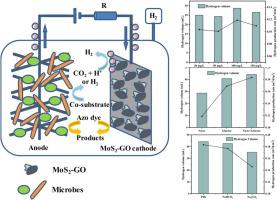当前位置:
X-MOL 学术
›
Process Biochem.
›
论文详情
Our official English website, www.x-mol.net, welcomes your
feedback! (Note: you will need to create a separate account there.)
Dye wastewater treatment and hydrogen production in microbial electrolysis cells using MoS2-graphene oxide cathode: Effects of dye concentration, co-substrate and buffer solution
Process Biochemistry ( IF 3.7 ) Pub Date : 2021-03-01 , DOI: 10.1016/j.procbio.2020.12.008 Yanping Hou , Lingli Tu , Shanming Qin , Zebin Yu , Yimin Yan , You Xu , Hainong Song , Hongfei Lin , Yongli Chen , Shuangfei Wang
Process Biochemistry ( IF 3.7 ) Pub Date : 2021-03-01 , DOI: 10.1016/j.procbio.2020.12.008 Yanping Hou , Lingli Tu , Shanming Qin , Zebin Yu , Yimin Yan , You Xu , Hainong Song , Hongfei Lin , Yongli Chen , Shuangfei Wang

|
Abstract A single-chamber microbial electrolysis cell (MEC) constructed with MoS2-GO nickel foam (NF) cathode was established for alizarin yellow R (AYR) decolorization and hydrogen production, and influences of AYR initial concentration, co-substrate and buffer on MECs performances were determined. The cathode was obtained by in-situ growing MoS2-GO on NF. Physico-chemical and electrochemical characterizations showed that MoS2-GO NF cathode exhibited superior performance towards catalytic hydrogen evolution. The decolorization efficiency of ∼ 90 % within 10 h was achieved with AYR initial concentrations ranging from 30 to 150 mg/L (PBS + NaAc medium), indicating that MECs performances were not severely inhibited as the mutual impact between electrochemically active bacteria (EAB) and azo dye decolorization. Improved hydrogen production (0.183 m3/d/m3) and COD removal (92.44 %) were obtained with NaAc + glucose co-substrate and PBS buffer, owing to lower cathodic potential, desired solution conductivity for charge transfer, and better growth of microbial communities under neutral condition. Besides, better MECs performances were obtained when using NaHCO3 as buffer, compared to Na2CO3, as milder environment could be provided for microbial growth by NaHCO3. Findings in this study could promote application potential of MECs for synchronous dye removal and clean energy production with proper operations.
中文翻译:

使用二硫化钼-氧化石墨烯阴极的微生物电解槽染料废水处理和制氢:染料浓度、共底物和缓冲溶液的影响
摘要 建立了 MoS2-GO 泡沫镍 (NF) 阴极构建的单室微生物电解池 (MEC) 用于茜素黄 R (AYR) 脱色和制氢,以及 AYR 初始浓度、共底物和缓冲液对 MECs 的影响表演被确定。通过在 NF 上原位生长 MoS2-GO 获得阴极。物理化学和电化学表征表明,MoS2-GO NF 阴极在催化析氢方面表现出优异的性能。在 AYR 初始浓度范围为 30 至 150 mg/L(PBS + NaAc 介质)时,10 小时内实现了约 90% 的脱色效率,表明由于电化学活性细菌(EAB)之间的相互影响,MECs 的性能没有受到严重抑制和偶氮染料脱色。提高氢气产量(0. 使用 NaAc + 葡萄糖共底物和 PBS 缓冲液可获得 183 m3/d/m3) 和 COD 去除率 (92.44%),这是由于较低的阴极电位、所需的电荷转移溶液电导率以及在中性条件下微生物群落的更好生长。此外,与 Na2CO3 相比,使用 NaHCO3 作为缓冲液时获得了更好的 MECs 性能,因为 NaHCO3 可以为微生物的生长提供更温和的环境。这项研究的结果可以促进 MEC 在适当操作下同步去除染料和清洁能源生产的应用潜力。与 Na2CO3 相比,当使用 NaHCO3 作为缓冲液时,可以获得更好的 MECs 性能,因为 NaHCO3 可以为微生物的生长提供更温和的环境。这项研究的结果可以促进 MEC 在适当操作下同步去除染料和清洁能源生产的应用潜力。与 Na2CO3 相比,当使用 NaHCO3 作为缓冲液时,可以获得更好的 MECs 性能,因为 NaHCO3 可以为微生物的生长提供更温和的环境。这项研究的结果可以促进 MEC 在适当操作下同步去除染料和清洁能源生产的应用潜力。
更新日期:2021-03-01
中文翻译:

使用二硫化钼-氧化石墨烯阴极的微生物电解槽染料废水处理和制氢:染料浓度、共底物和缓冲溶液的影响
摘要 建立了 MoS2-GO 泡沫镍 (NF) 阴极构建的单室微生物电解池 (MEC) 用于茜素黄 R (AYR) 脱色和制氢,以及 AYR 初始浓度、共底物和缓冲液对 MECs 的影响表演被确定。通过在 NF 上原位生长 MoS2-GO 获得阴极。物理化学和电化学表征表明,MoS2-GO NF 阴极在催化析氢方面表现出优异的性能。在 AYR 初始浓度范围为 30 至 150 mg/L(PBS + NaAc 介质)时,10 小时内实现了约 90% 的脱色效率,表明由于电化学活性细菌(EAB)之间的相互影响,MECs 的性能没有受到严重抑制和偶氮染料脱色。提高氢气产量(0. 使用 NaAc + 葡萄糖共底物和 PBS 缓冲液可获得 183 m3/d/m3) 和 COD 去除率 (92.44%),这是由于较低的阴极电位、所需的电荷转移溶液电导率以及在中性条件下微生物群落的更好生长。此外,与 Na2CO3 相比,使用 NaHCO3 作为缓冲液时获得了更好的 MECs 性能,因为 NaHCO3 可以为微生物的生长提供更温和的环境。这项研究的结果可以促进 MEC 在适当操作下同步去除染料和清洁能源生产的应用潜力。与 Na2CO3 相比,当使用 NaHCO3 作为缓冲液时,可以获得更好的 MECs 性能,因为 NaHCO3 可以为微生物的生长提供更温和的环境。这项研究的结果可以促进 MEC 在适当操作下同步去除染料和清洁能源生产的应用潜力。与 Na2CO3 相比,当使用 NaHCO3 作为缓冲液时,可以获得更好的 MECs 性能,因为 NaHCO3 可以为微生物的生长提供更温和的环境。这项研究的结果可以促进 MEC 在适当操作下同步去除染料和清洁能源生产的应用潜力。

















































 京公网安备 11010802027423号
京公网安备 11010802027423号